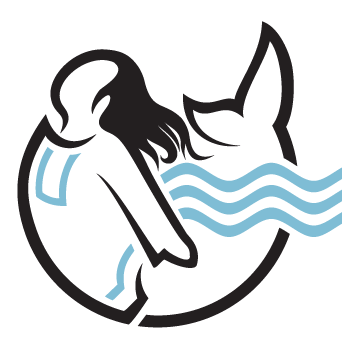WITH GRATITUDE
Team Sedna is incredibly grateful to Santi for acting as the anchor sponsor of this expedition, providing the group with heated drysuits, expedition wear and continuous support.

Team Sedna is incredibly grateful to Santi for acting as the anchor sponsor of this expedition, providing the group with heated drysuits, expedition wear and continuous support.
Susan R. Eaton, founder and leader of the 2014-2016 SEDNA Epic Expedition, is a Calgary-based geologist, geophysicist, conservationist and journalist. Eight years ago, Susan suffered a scuba diving trauma that landed her in a hyperbaric chamber and ended her diving career. Undaunted, her life-long relationship with the ocean (which had included teaching diving) didn’t end in the hyperbaric chamber.
Today, Susan explores the world’s oceans—from Antarctica to the Arctic—in the snorkel zone, a dynamic land-sea-air-ice interface where large animals approach snorkelers and where the exhalations of marine mammals and snorkelers often comingle. A member of the Explorers Club, she will lead Team Narwhal.
Dr. Caroline Bain is a dive instructor and physician with a family practice in Calgary. Trained in hyperbaric (diving) medicine, Caroline also treats patients with scuba diving traumas. As the Sedna Expedition’s physician, Caroline will monitor the safety of the snorkelers and divers in waters that can approach minus two degrees Celsius. She’ll also conduct hyperbaric research—including administering WIFI pills to the snorkelers to transmit vital core body temperature data—ensuring that they are medically fit to snorkel and scuba dive in unforgiving arctic waters.
Ruby Banwait is an aquarium biologist at the Vancouver Aquarium who specializes in fishes and invertebrates of the Pacific Northwest and the Arctic. In 2013, Ruby assisted in opening the Petty Harbour Mini Aquarium, one of the world’s few catch-and-release style facilities. As the mini-aquarium’s curator and dive safety officer, Ruby introduced some 17,000 visitors to the flora and fauna of the North Atlantic, during the first six months of the mini aquarium’s operations, discussing sustainable fisheries and the coastal culture of Newfoundland.
Charlene Barker is a Calgary-based master dive instructor and cave diver with a passion for ice diving in mountain lakes and exploring cenotes (sink holes and their associated cave systems) in the Yucatan Peninsula. A member of the 2013 Royal Canadian Geographic Society-sponsored Raspberry Rising Expedition, Charlene has dived beneath British Columbia’s mountains which host some of the most unexplored and deepest cave systems in the world. The founder of two of Canada’s most successful scuba stores—in the land-locked prairies—Charlene has introduced more than 12,000 adults and youths to the joys of scuba diving and snorkeling.
Erika Bergman is a Seattle-based chemical oceanographer, educator and submersible pilot who ‘flies’ a five-man submarine, exploring the ocean down to 300 meters. Erika has three years of experience, as a manned submersible pilot and technician, for submersibles including Antipodes, Suds, Curasub, and Idabel. Named a 2013 National Geographic Young Explorer, Erika recently conducted a National Geographic expedition to study the deep coral reefs of the islands of Curaçao and Roatan. An engaging story teller, she uses her submersible as a vehicle to inspire students to explore the oceans and to pursue marine careers.
Emily Dowding-Smith is based in Auckland. Called to the bar in New Zealand, Emily is a lawyer with a masters degree in environmental science, policy and management. An avid scuba diver, she seeks creative solutions to environmental challenges, effecting positive change through awareness and education. During the past six years, she has worked in Germany on climate change issues. Emily convened the program and sessions of the 3rd and 4th Global Forums on Urban Resilience and Adaptation to Climate Change for ICLEI, in Bonn, Germany.
Françoise Gervais is a deep-sea explorer, environmental conservation specialist, educator, photographer and cold-water diver based in Victoria. Employed with Ocean Networks Canada, Françoise has participated in a number of oceanographic expeditions, surveying and cataloging the ocean’s deep sea organisms. She has conducted bird surveys for Ducks Unlimited and the Nature Conservancy, and has contributed to the creation of several natural reserves. A native of Québec, la belle province, extreme environments are in her blood and she feels at home when most challenged by them.
Jill Heinerth is an underwater explorer, dive instructor, filmmaker and cave diver based in Gainesville, Florida. In 2013, Jill and her husband cycled 7,000 kilometres across Canada to raise awareness of water conservation issues. The recipient of numerous international awards, including the Royal Canadian Geographical Society’s 2013 Sir Christopher Ondaatje Medal for Exploration, she led a National Geographic expedition to Antarctica, being the first person to explore the inside of an iceberg. A fellow of the Explorers Club and an inductee in the inaugural class of the Women Divers Hall of Fame, Jill will lead Team Beluga and assist in filming the July 2014 Expedition.
Becky Kagan Schott is an Emmy award-winning underwater videographer, journalist and dive instructor from Philadelphia. Her work can be seen on National Geographic, Discovery Channel and Animal Planet. Becky has worked closely with the Woods Hole Oceanographic Institution’s Advanced Imaging and Visualization Laboratory using the latest in high-definition and 3D technology, both above and below the surface. A fellow of the Explorers Club and an inductee in the Women Divers Hall of Fame, Becky believes in advancing marine conservation through using her compelling imagery. Becky will film the July 2014 Expedition.
Renata Rojas is a Mexican master diver based in New York. Renata has world-wide experience which includes cage diving with the great white sharks of Guadalupe. Born in Mexico City, Renata started diving in Cozumel, at the age of twelve. Her childhood fascination with the RMS Titanic culminated with Renata joining the 2012 Titanic Expedition to dive (in a submersible) more than 12,000 feet to the ship’s final resting place. Renata’ dive was cancelled twice but she still dreams of diving on the RMS Titanic one day. Out of the water, she works for a large European bank, as a director of loan syndications and trading, with a focus on Latin America.
Most scientists agree that the Arctic Ocean will be mostly free of ice in the summer in the near future. Whether it happens in the next ten or thirty years, the future is clear.
Sea ice is reflective, bouncing the sun’s rays back into space. When it melts, the dark blue ocean absorbs heat. Later on, the heat is released back into the atmosphere, heating up the rest of the planet. Temperatures in the Arctic are rising faster than anywhere else on earth – about three times faster.
As the Arctic ice melts, it adds freshwater to the oceans. The melting of the massive ice sheet covering Greenland may eventually contribute to a rise of up to 9 millimeters. That might not seem like much, but it is enough to dramatically change life in coastal communities around the world.3. Thawing permafrost amplifies warming.
Scientists are concerned about materials that are currently locked up in permanently frozen regions of the north. As they thaw, they will release carbon dioxide, methane and other gases that contribute to the overall greenhouse gases that can further accelerate warming.
As freshwater runs into the sea, it produces a different overall map of water temperatures on earth. Ocean currents act as conveyor belts delivering waters that either warm or cool a particular region. The Gulf Stream brings water up from the south to create a relatively warm British climate. Precipitation follows these currents too. If they shift or slow down, these regional climates could be very different in the future. A changing regional climate affects food supply, water distribution and everything about a known way of life.
Many North Americans would scoff at the suggestion of global warming after experiencing the harsh North American winter of 2013-2014. However, this is indeed a symptom of global climate change. As temperatures rise quickly in the Arctic, they eclipse the changes further south. There is a greater temperate and pressure gradient that results in the right conditions for severe weather. With the Jet Stream meandering further south in less predictable ways, the very cold Arctic air reaches much lower latitudes in North America. Where the cold and warm air meet, extreme weather erupts.
Where Whales Went to Die We went diving in a graveyard of whales in Dildo, Newfoundland. Thankfully the practice of whaling has long passed in the these waters, but I was struck with the sadness of such a place. Whale carcasses were stripped of all their useful parts and then discarded in this bay. The backbones lead the dive through ribbons of solemnity and when you arrive at a great skull, you are stopped by the magnificent size. I’m hopeful we will swim with these great creatures on our expedition and celebrate them in their majestic life.
I was diving on the wreck of the Rosecastle this morning with Cas Dobbin and used my new Santi heated gloves for the first time. It was glorious. I can’t imagine how I worked without them. We had an hour on the wreck which sites in 150 feet of water. The temperature is 1°C on the bottom and I was comfortable for the duration of the dive. The under gloves are great insulators even without the heat. They sit inside my Kubi dry gloves and mate to the suit with a metal ring that is sealed with an O-ring. A small…
Few Canadians are aware of the time when WWII came to the shores of Newfoundland. During the Second World War, mines on Bell Island, Newfoundland supplied iron ore to Cape Breton’s steel mills, accounting for one third of Canada’s steel production. Germany knew that if they interrupted this flow of ore, even temporarily, Canada’s war output could be seriously affected. On the night of September 4th, 1942, a German U-Boat followed the ore carrier Evelyn B into its anchorage. The next morning and under the guns of the Bell Island Battery, the U-Boat sank two ships: SS Saganaga and SS…

In July 2016, a team of ten passionate women will embark on an epic three-month journey, snorkeling over 3,000 kilometers through frigid Arctic seas from Pond Inlet, Nunavut, to Inuvik, Northwest Territories. Supported by a mother ship equipped with two rigid hull boats, the snorkelers will scout and document the impacts of global warming on this fragile arctic ecosystem and on the aboriginal peoples’ traditional ways of life.
Through cross-cultural dialogue and educational outreach, the 2014-2016 Sedna Epic Expedition will record on-the-ground climate change observations of Inuit and Inuvialuit Elders. Providing educational and life role models, Team Sedna will reach out to Inuit and Inuvialuit women and girls, empowering them to build resilient communities to combat the impacts of climate change.
Immersing itself in the issue of disappearing sea ice, Team Sedna will translate its findings into educational and awareness programs on climate change and disappearing sea ice. The Expedition will serve as a “call to action” for citizens of the world, including youth, providing aboriginal and scientific knowledge to inform governments on implementing science-based policies to mitigate global warming. The Expedition will also serve to inspire women and girls to think “big,” and to follow their dreams, no matter how out of the box they may appear…
Before tackling the 100-day Northwest Passage Snorkel Relay during the summer of 2016, Team Sedna will mount an 15-day, action-packed expedition in July 2014. Traveling aboard the 116-foot MV Cape Race, along the Labrador coast to Baffin Island and across the Davis Strait to Western Greenland, the sea women will conduct team-building exercises, perform oceanographic studies, deliver educational outreach in Inuit communities and broadcast their findings to the world. Further, they’ll demonstrate that snorkelers—using diver propulsion vehicles—can successfully ‘go the distance’ through ice-infested arctic waters.
Sedna is an ancient Inuit goddess of the sea. Her mythology has been retold by storytellers from the indigenous peoples of the North. Inuit peoples describe a teenage girl who refused to marry a man prescribed by her father. She ran away with a mysterious masked figure who turned out to be a Fulmar seabird. Her father rescued her from the sea bird colony, but when they attacked him in his kayak, he threw his daughter overboard. As she clung to the edge of the boat, he cut off her fingers one by one. Sedna slipped below the waves and as her fingers dropped below the surface they each took the form of a marine mammal. Sometimes angry with mankind, Sedna releases violent storms and waves. For millennia, Inuit Shamans have entered the sea to soothe her and comb her long black hair. Once calmed, Sedna releases the seals and whales for a bountiful hunt.

Illustration by Jill Heinerth